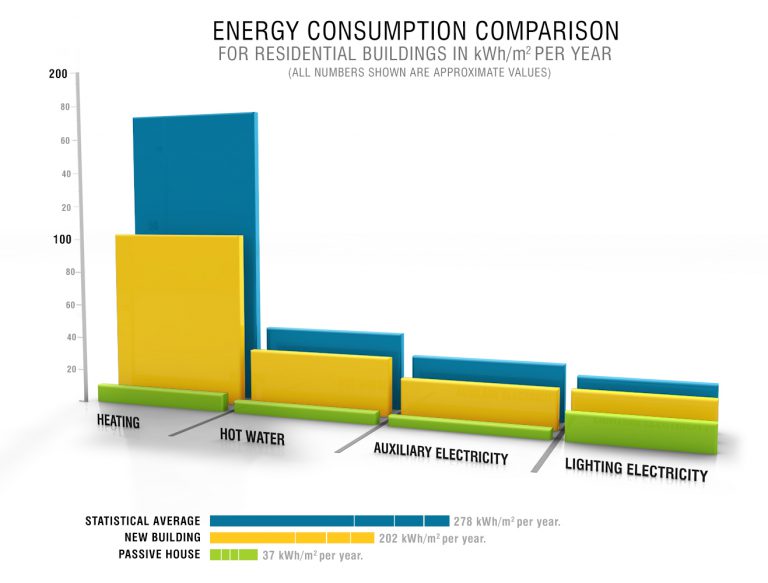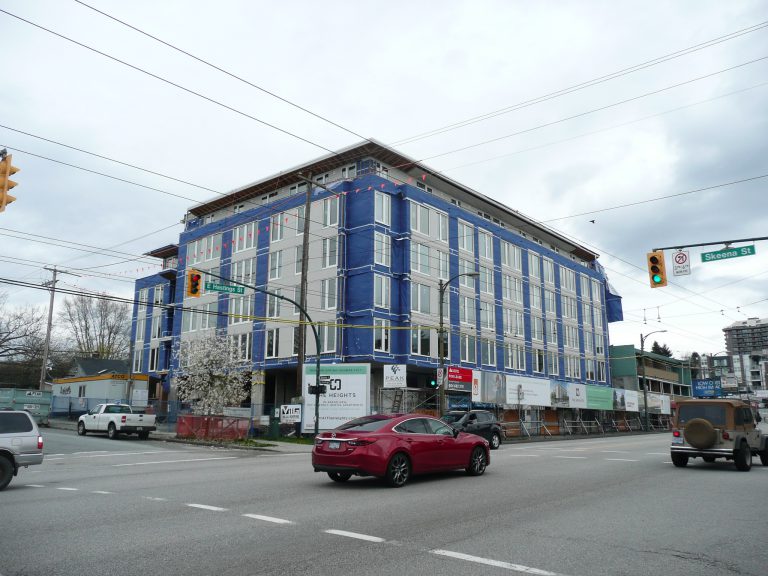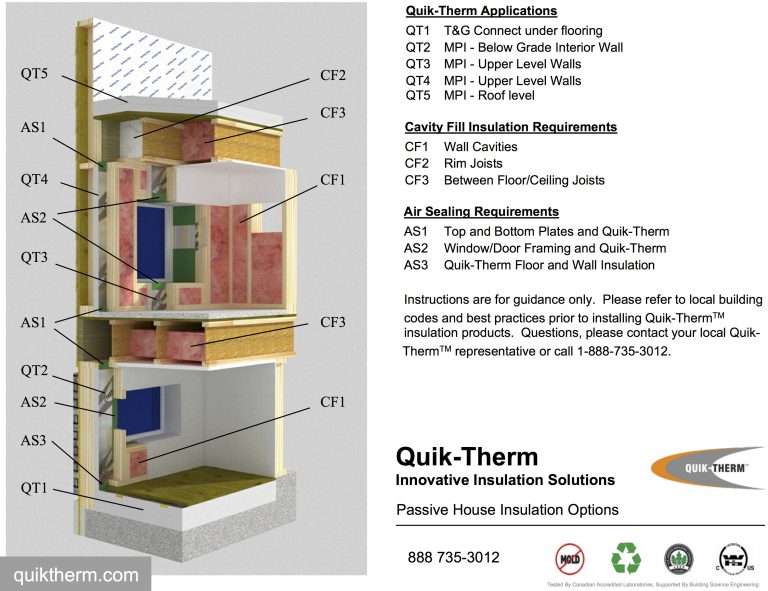Passive House is one of the most stringent energy efficiency certifications for buildings. There are a multitude of factors that affect the building’s performance, however certification boils down to essentially two aspects. Energy usage is one of them. The building must use less than a certain amount of energy relative to the footprint (15 kWh/m2a). It must also meet a certain level of air tightness (0.6 ACH). How you achieve these targets is almost irrelevant – as long as you hit them. In the end, Passive Homes end up using roughly 75-90% less energy than conventional homes. Passive house U values range from 0.10 to 0.15 W/(m²K). The R value for walls in passive house can differ from region to region, but normally passive house R value is R 30-50
What about the cost? It is significantly smaller than one may suspect. An investment of only 2-7% is required for a substantial pay off in energy savings. The monthly savings in energy costs outweigh the increased monthly mortgage payments. The total investment cost of the house goes up, but monthly expenditures of mortgage and utilities can stay the same if not decrease.
With many energy efficient products, the pay bay or break even is sometimes brought up. The math can be done, but I quite often pose the question: what is the payback of those expensive granite countertops? Nobody considers this, as there is no financial return to these expensive aesthetic upgrades. Meanwhile, these items can be easily upgraded in the future. On the contrary, it is quite difficult to go back and increase the amount of insulation in your home. If you are going to insulate your home (or other building), then do it once, do it right, and put the investment into it.
Invest in Quik-Therm’s continuous rigid insulation with drainage gap. We can provide a variety of solutions to match the needs of each individual project. What kind of insulation needs are required for Passive House certification? Well, whatever R / RSI value will make your building use no more than the 15 kWh/m2a target. Keep in mind the 0.6O ACH air tightness that needs to be achieved. Wouldn’t it be great if you can have an insulation that can help with both of these targets simultaneously? Quik-Therm certainly thinks so!
Cornerstone Architecture has designed Canada’s largest passive house building, and Peak Construction is nearly finished building it. It is located in Vancouver, BC, and has 85 units, plus retail space on the main floor. This is a precedent for the building industry, showing that these extremely energy efficient projects are not just viable, but profitable. Since Vancouver wants to be a Net Zero city by 2030, they are paving the way for the rest of the country for what is coming up next in building codes.
For this project, they decided to use two wood stud walls, with a layer of Quik-Therm’s Multi-Purpose Insulation sandwiched in the middle. This provides a substantial amount of continuous insulation, making the wood stud walls with fibreglass batts perform even better. Since Quik-Therm has a plastic reflective facer on either side, it is also acting as the vapour barrier by taping the seams. For the floors, they are using Quik-Therm Connect to take advantage of the built-in wood inserts . A 6″ layer of Connect overtop of the concrete ensures an excellent thermal break, while providing a fastening method for flooring.
How Thick Are Passive House Walls?
I have seen a lots of passive house walls profiles and inevitably the passive house exterior wall thickness can get quite thick. They start to look like passive house double walls. In addition, there is a significant amount of wood used – significantly more than is required. For “ease” you can design a 2×18″ wood stud wall with cavity fill and use the same old conventional way of building as is currently used for 2×6″ residential construction. However, this does not make sense and there are more efficient ways of building. For many of these walls, I like to use the saying there is an inefficient use of structural materials. Why use more wood than you need? It creates thermal bridging and lowers the usefulness of cavity fill insulation, is expensive and labour intensive, and puts pressure on the trees of our planet. In 95% of all residential homes only a 2×4″ wood stud is required for structural integrity. The only reason builders build with 2×6″ is to meet the insulation requirement: by having a bigger cavity to put in a thicker batt. (Quik-Therm helped the Home of Tomorrow by showing they can increase energy efficiency by using 2″ Connect on the exterior of a 2×4″ wall.)
A great alternative to these large passive house external wall thickness challenges is what we are doing for an upcoming Passive House project in Vancouver. They have a conventional 2×6″ wood stud wall with cavity fill, which they can use for their electrical and plumbing requirements. Outside of that, they are putting a 6″ layer of Connect, which has the built-in wood strapping making it quite easy to fasten. This layer will also constitute as the air/vapour barrier. Overtop of the Connect they are going to attach a layer of Solar Dry to integrate a rain screen. This alleviates ALL the effects of thermal bridging, minimizes wall thickness, and provides ease and simplicity of installation.
Quik-Therm is a member of the Passive House of Canada. We have a few key distributors that have taken specialized training on how to build Passive Homes and the best way to reach the targets. Even if you aren’t looking to achieve certification, the principles can be used to increase energy efficiency in your next project. Passive House is the way of the future, and it is certainly starting to gain significant momentum. I have heard that there are “millions of square feet in the design pipeline for Passive House projects.”.
Passive House Wall Insulation
Every project is unique and different, with its own constraints and challenges. Why not contact a Quik-Therm distributor to help ensure energy efficiency for your next building? When it comes to insulating a building, do it once, do it right, and let us help you. Our passive house insulation solution is cutting edge. Purchase the best passive house wall section in Canada today!



